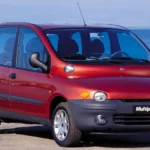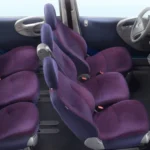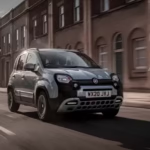InsightGirl-Urteil
Der Fiat Multipla mag wie ein außerirdisches Raumschiff aussehen, doch unter seinem exzentrischen Design verbirgt sich ein praktischer, überraschend vielseitiger MPV mit einem der funktionalsten Innenräume, die je in einem Familienauto verbaut wurden.
Vorteile
- + Wirklich innovative 3+3-Sitzanordnung
- + Jede Menge Platz im Innenraum für Passagiere und Ladung
- + Hervorragende Sicht und aufrechte Fahrposition
- + Überraschend gut zu fahren für einen MPV
- + Einfache Wartung und günstige Teile
- + Hoher Kraftstoffverbrauch für seine Größe
- + Kultklassiker-Status und wachsende Retro-Anziehungskraft
Nachteile
- – Berüchtigtes Außendesign schreckt viele Leute ab
- – Kunststoffe im Innenraum fühlen sich billig und kratzig an
- – Laute Kabine bei höheren Geschwindigkeiten
- – Es fehlt an moderner Sicherheitsausrüstung
- – Einige frühe Dieselversionen neigen zu elektrischen Problemen
Als ich den Fiat Multipla zum ersten Mal sah, hatte ich die gleiche Reaktion wie die meisten Leute: Was in aller Welt ist das? Mit seinen glotzäugigen Frontscheinwerfern und den gedrungenen Proportionen sah er eher wie ein wissenschaftliches Experiment als wie ein Familienauto aus. Aber nachdem ich den Multipla über zwei Jahre lang gefahren bin, kann ich ehrlich sagen, dass er einer der am meisten missverstandene Autos aller Zeiten– und möglicherweise eines der praktischsten.
Dies wird kein Liebesbrief an den Multipla. Er hat Mängel – viele sogar –, aber wenn Sie auf der Suche nach Ehrlichkeit, Zweckmäßigkeit und einem Auto sind, das nicht der Herde folgt, lesen Sie weiter.
Ein kurzer Überblick

Der Fiat Multipla wurde 1998 eingeführt und lief bis 2010. Er basierte auf der Fiat Bravo/Brava-Plattform, verfügte aber über eine unkonventionelle Karosserie, die man nur als… „einzigartig“ bezeichnen konnte. Es ist ein kompakter MPV, der bietet sechs Sitze in zwei Reihen– eine Konfiguration, die nur sehr wenige Hersteller überhaupt zu versuchen wagten.
Ich fuhr den Facelift-Modell 2004, was die Seltsamkeit etwas abschwächte, aber dennoch den Charakter beibehielt, der den Multipla zu einem so ungewöhnlichen Favoriten machte.
Außendesign – Lieben oder hassen

Lassen Sie uns das Offensichtliche ansprechen: das Design. Der Multipla vor dem Facelift (1998–2003) wird aufgrund seiner doppelstöckigen Frontpartie – Scheinwerfer, die wie Froschaugen über der Motorhaubenlinie angeordnet sind – häufig in Listen der „hässlichsten Autos“ genannt.
Bei der überarbeiteten Version, die ich besaß (2004), wurden die gestapelten Scheinwerfer zugunsten eines konventionelleren Aussehens weggelassen, aber es war immer noch nicht das, was man als schön bezeichnen würde. Die hohe Karosserie, die geringe Länge und die breite Haltung lassen es aus manchen Blickwinkeln seltsam aussehen.
Das heißt, wenn man sich erst einmal daran gewöhnt hat, gibt es eine gewisse Charme zum Multipla. Er versucht nicht, elegant oder sportlich zu sein; er schreit: „Ich bin hier, um Menschen zu transportieren, nicht um die Blicke auf mich zu ziehen.“
Innenraum und Funktionalität – Überraschend brillant

Hier kommt nun der Multipla glänzt wirklich. Der Innenraum ist ohne Frage einer der intelligentesten Grundrisse, die ich je in einem Auto dieser Größe gesehen habe.
Sechs vollwertige Sitze Die Anordnung in zwei Dreierreihen bedeutet, dass selbst der mittlere Passagier einen richtigen Sitzplatz bekommt – und nicht nur eine winzige Stange wie in den meisten MPVs. Und anders als bei 7-Sitzern, bei denen die letzte Reihe normalerweise ein beengter Nebeneinfall ist, bietet der Multipla jedem Raum zum Atmen.
Ich bin 1,88 m groß und könnte auf jedem der sechs Sitze bequem sitzen. Bein- und Kopffreiheit sind hervorragend. Der flache Boden trägt zum großzügigen Raumgefühl bei, und die Sicht ist dank der hohen Sitzposition und der großzügigen Glasfront hervorragend.
Speicherplatz ist reichlich vorhanden: Schubladen unter den Sitzen, Getränkehalter an ungewöhnlichen Stellen, ein riesiges Handschuhfach, und überall kleine Fächer. Es ist, als würde man eine TARDIS fahren. Auch der Kofferraum ist großzügig – selbst wenn alle sechs Sitze belegt sind, stehen noch 430 Liter zur Verfügung. Klappt man die Rücksitze um, wird der Wagen zu einem kleinen Van.
Fahrerlebnis – Nicht für Nervenkitzel gebaut, aber leistungsfähig
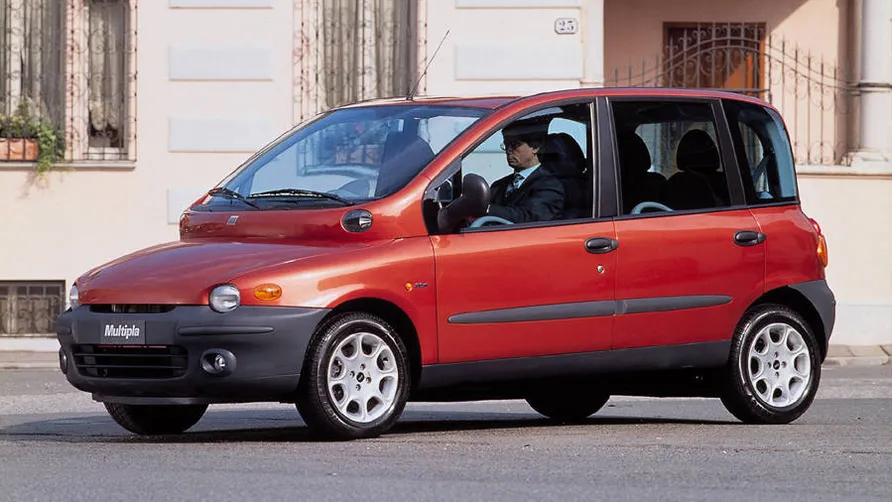
Tun wir nicht so, als wäre dies ein Auto für den Fahrer. Beim Multipla ging es nie um Leistung oder Handling. Er fährt sich jedoch überraschend gut –besser als die meisten erwarten würden.
Dank der breiten Spur und des niedrigen Schwerpunkts meistert er Kurven sicherer als ein großer MPV. Die Federung ist zwar immer noch weich, aber das hilft, Schlaglöcher und Bodenwellen zu absorbieren.
Mein Multipla hatte die 1,9-Liter-JTD-Dieselmotor, mit rund 115 PS. Er ist nicht schnell – von 0 auf 100 km/h dauert er etwa 12 Sekunden –, aber er zieht gut durch und gleitet komfortabel über die Autobahn. Das Fünfgang-Schaltgetriebe fühlt sich solide an, und die Übersetzungsverhältnisse sind gut auf das Drehmoment des Motors abgestimmt.
In der Stadt lässt es sich trotz seiner Breite leicht manövrieren. Parksensoren sind jedoch ein Geschenk des Himmels – die dicken hinteren Säulen und die hohe Kofferraumlinie können das Rückwärtsfahren schwierig machen.
Die Geräuschdämmung ist nicht besonders gut. Ab 110 km/h werden Wind- und Motorgeräusche zwar deutlich wahrnehmbar, aber nicht unerträglich. Dies ist ein Familienauto, kein Luxuskreuzer.
Kraftstoffverbrauch und Betriebskosten
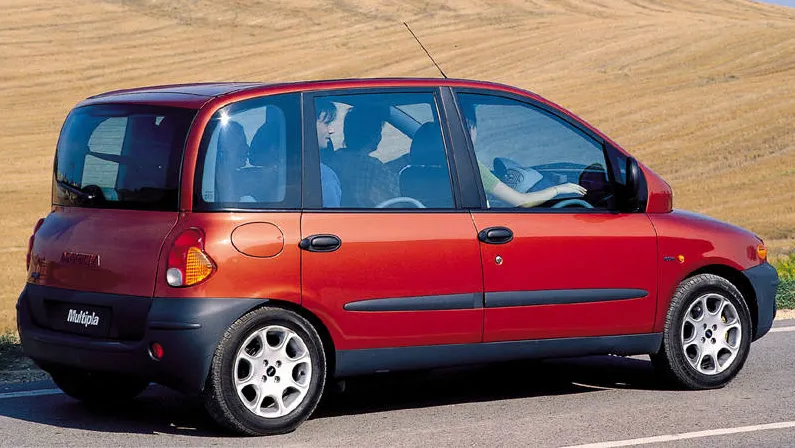
Der 1.9 JTD war bemerkenswert effizient für seine Zeit. Ich durchschnittlich etwa 45–48 mpg im gemischten Fahrbetrieb, was für einen MPV mit großer Karosserie und Dieselmotor solide ist.
Die Wartungskosten waren angemessen und Ersatzteile waren überraschend leicht zu beschaffen – auch heute noch. Fiats Ersatzteillager ist umfangreich und viele Komponenten werden mit dem Bravo, Brava und sogar einigen Alfa Romeos dieser Zeit gemeinsam genutzt.
Auch die Versicherung war eher niedrig, sodass es eine gute Option für Familien mit kleinem Budget war.
Zuverlässigkeit – ein gemischtes Bild
Hier wird es etwas trübe. Fiat hatte noch nie den besten Ruf für Zuverlässigkeit, und der Multipla ist keine Ausnahme. In den zwei Jahren, in denen ich das Gerät besaß, hatte ich:
- Ein defektes AGR-Ventil (Austausch 200 £)
- Ein klemmender hinterer Bremssattel
- Ein defekter Fensterhebermotor auf der Fahrerseite
- Mehrere Warnleuchten, die sich durch Aus- und Wiedereinschalten des Autos von selbst reparierten
Nichts davon war katastrophal, aber es erinnert daran, dass der Multipla seinen Preis hatte. Wenn Sie technisch begabt sind oder einen guten unabhängigen Mechaniker haben, ist das zu bewältigen. Aber es ist kein Auto, das man vernachlässigen kann.
Infotainment und Funktionen – einfach, aber funktional
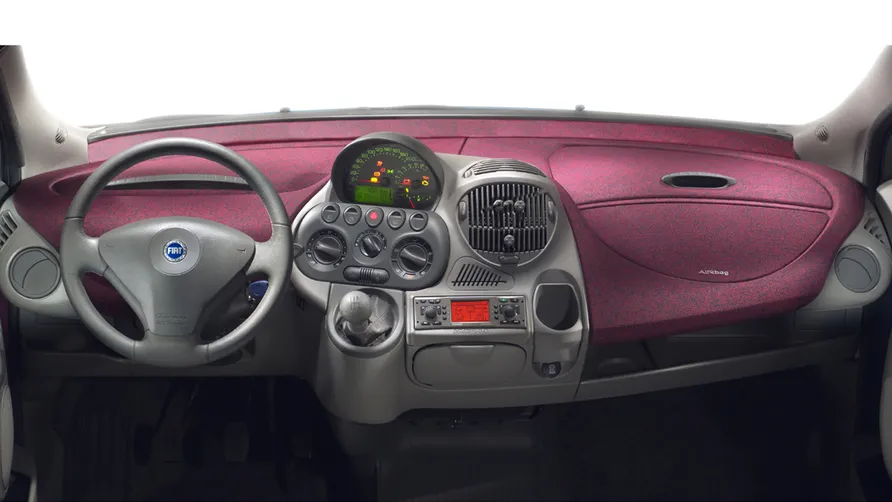
Der Multipla war zwar nicht mit Hightech-Funktionen vollgestopft, hatte aber alles, was die meisten Familien Anfang der 2000er Jahre brauchten:
- Manuelle Klimaanlage (funktioniert einwandfrei)
- Ein CD-Player mit sechs Lautsprechern (Klangqualität ist durchschnittlich)
- Elektrische Fensterheber
- Beheizte Spiegel
- Einige Modelle verfügten sogar über Parksensoren und Geschwindigkeitsregler
Das ist alles. Es gibt keinen Touchscreen, Bluetooth oder Navigation. Aber es gibt Steuerungen, die Sinn machen, Tasten dort, wo Sie sie erwarten, und ein digitaler Bordcomputer, der Reichweite, Kraftstoffverbrauch und Außentemperatur anzeigt.
Sicherheit – eine solide Leistung für die damalige Zeit
Der Multipla punktete respektable vier Sterne im Euro NCAP-Test damals, als es auf den Markt kam. Es hatte:
- ABS mit EBD
- Fahrer- und Beifahrerairbag
- Seitenairbags bei einigen Modellen
- Höhenverstellbare Sicherheitsgurte
- ISOFIX-Kindersitzverankerungen
Strukturell fühlt es sich robust an. Die breite Standfläche verleiht ihm Stabilität und Sie fühlen sich im Inneren immer sicher, auch wenn es voll beladen ist.
Macken und Kuriositäten – Der Multipla-Weg
Was wäre eine Multipla-Rezension ohne die Erwähnung der seltsame Teile? Hier sind ein paar Dinge, die ich seltsam, aber liebenswert fand:
- Die Handbremse befindet sich am Armaturenbrett. Ja, es lässt sich nach vorne klappen und rastet ein. Anfangs seltsam, aber es schafft Platz zwischen den Vordersitzen.
- Der Schalthebel sprießt aus dem Armaturenbrett, ähnlich wie bei einem Van. Sobald man sich daran gewöhnt hat, ist es ergonomisch und macht das Schalten zu einem Kinderspiel.
- Sie sitzen extrem aufrecht, fast wie in einem Bus. Die Sicht ist hervorragend, aber gewöhnungsbedürftig.
- Die Leute werden starren. Egal, wie sehr Sie Ihren Multipla lieben, andere werden eine Meinung dazu haben – und sie werden sie teilen.
Endgültiges Urteil – Ein Auto, das es wagt, anders zu sein
Der Fiat Multipla ist nicht jedermanns Sache. Wenn Sie elegante Optik, Hochgeschwindigkeits-Nervenkitzel oder moderne Technologie suchen, sollten Sie woanders suchen. Aber wenn Sie Wert legen cleveres Design, unübertroffene Funktionalität und ein bisschen automobile Seele, der Multipla liefert.
Bei diesem Auto steht die Funktion über der Form – und das ist in Zeiten von Crossover-Looks und aufgeblähten SUVs erfrischend. Für Familien, Hobbyisten oder einfach Liebhaber des Seltsamen und Wunderbaren ist dieses Auto einen zweiten Blick wert.
Fiat Multipla Scorecard
| Kategorie | Punktzahl (von 10) |
|---|---|
| Styling | 4 |
| Funktionalität im Innenraum | 10 |
| Fahrerlebnis | 6 |
| Kraftstoffverbrauch | 7 |
| Zuverlässigkeit | 5 |
| Preis-Leistungs-Verhältnis | 8 |
| Komfort | 7 |
| Features & Technik | 4 |
| Sicherheit | 6 |
| Gesamtcharakter | 9 |
Spezifikationen und Preise
Allgemeine Informationen | |
| Hersteller | Fiat |
| Modellname | Multipla |
| Fahrzeugtyp | Kompaktes MPV (Mehrzweckfahrzeug) |
| Karosseriestil | 5-türiger Fließheck/MPV |
| Produktionsjahre | 1998–2010 |
| Fertigungsstandort | Turin, Italien |
| Ursprünglicher Preis (2004) | ~$18.000 USD |
Kraft und Leistung | |
| Motoroptionen | 1,6 l Benzin, 1,9 l JTD-Diesel, 1,9 l Multijet-Diesel |
| Pferdestärken | 103–120 PS (77–89 kW) |
| Drehmoment | 145–206 Nm (107–152 lb-ft) |
| Höchstgeschwindigkeit | 165–180 km/h (102–112 mph) |
| 0–100 km/h (0–62 mph) | 12,6–14,5 Sekunden |
| Kraftstoffart | Benzin oder Diesel |
| Kraftstoffverbrauch | 5,7–8,6 l/100 km (27–41 mpg) |
Getriebe und Antriebsstrang | |
| Übertragung | 5-Gang-Schaltgetriebe oder 6-Gang-Schaltgetriebe |
| Laufwerkstyp | Frontantrieb (FWD) |
| Kupplung | Hydraulische Einscheiben-Trockenkupplung |
Innenraum und Kapazität | |
| Sitzkonfiguration | 6 Sitze (3 vorne, 3 hinten) |
| Boot-Speicherplatz | 430–1.900 Liter je nach Sitzanordnung |
| Innenausstattung | Klimaanlage, Klappsitze, optionaler CD-Player |
Abmessungen und Gewicht | |
| Länge | 3.990 mm (157 Zoll) |
| Breite | 1.875 mm (74 Zoll) |
| Höhe | 1.690 mm (67 Zoll) |
| Radstand | 2.665 mm (105 Zoll) |
| Leergewicht | 1.250–1.380 kg (2.755–3.042 lbs) |
| Bodenfreiheit | 140 mm (5,5 Zoll) |
Bemerkenswerte Funktionen | |
| Am Armaturenbrett montierter Schalthebel | Ja |
| Modulare Sitzgelegenheiten | Komplett herausnehmbare Rücksitze |
| Infotainment | Basisradio/CD, optionale Navigation bei späteren Modellen |
| Sicherheit | ABS, Airbags, optionale Stabilitätskontrolle |
Varianten | |
| Multipla Bipower | Benzin/CNG (Compressed Natural Gas)-Hybrid |
| Multipla JTD | Dieselbetriebene Version |
| Facelift (2004+) | Weicherer, konventionellerer Stil |
Verfügbare Lackfarben |
| Silber, Rot, Blau, Beige, Grün, Gelb, Schwarz, Weiß |
Preise | |
| Gebrauchtpreis (durchschnittlich, guter Zustand) | |
| Vereinigte Staaten (USD) | $2.500–$5.500 |
| Europäische Union (EUR) | 2.000–4.800 € |
| Vereinigtes Königreich (GBP) | 1.800–4.200 £ |




